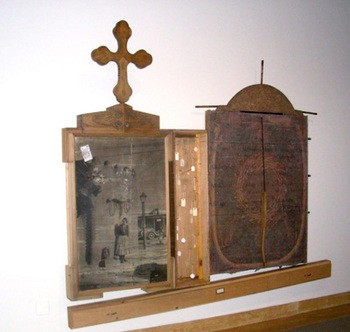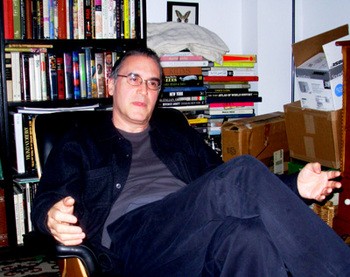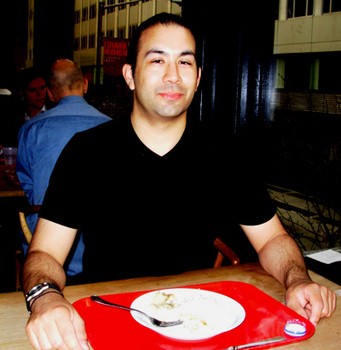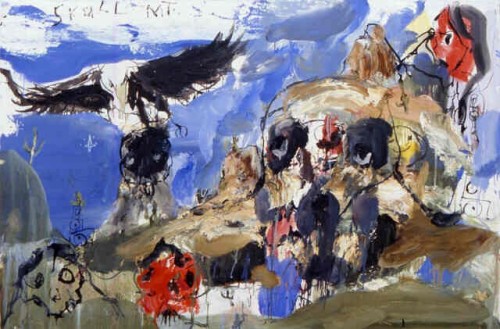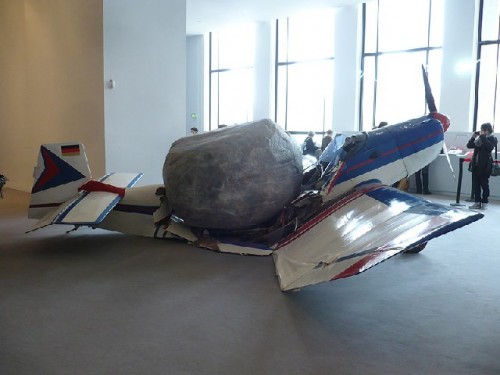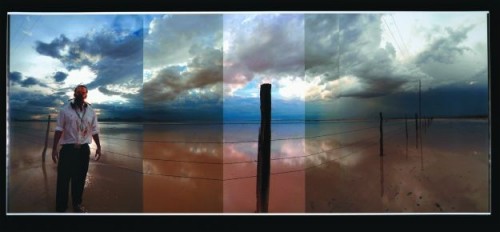Encountering Native New Yorkers
An Ongoing Vision Quest
By: Charles Giuliano - Sep 23, 2013
I asked Jaune Quick To See Smith if she could identify the most famous and successful contemporary native artist? She started to recite a list of names, some of whom I am familiar with, but I interrupted. “No,” I said. “The most famous contemporary native artist is Robert Rauschenberg.”
She laughed at that observation because the artist has a Cherokee mother. Professionally, however, he has made little public effort to identify with that heritage. The issue was relevant when I met with the video, installation artist, Alan Michelson, whom I had heard lecture at College Art Association. He discussed how he had discovered the identity of his Mohawk birth mother from his adoptive parents when he was in his twenties while attending the School of the Museum of Fine Arts. He is now a registered member of the Six Nations Indian Reserve in Ontario, Canada where he spends an average of six weeks each year.
On the other hand, when asked whether he spent time on the reservation the brilliant and feisty, young Apache artist, Jason Lujan, whom I met for lunch in the staff cafeteria of the Museum of Modern Art where he “keeps an office” shrugged it off. He doesn’t really dwell on the issues of his identity and is more about being Indian, expressing that in his work quite vividly, rather than acting Indian. He also concedes the complexities and relates that he “goes back and forth” on a lot of the issues of history, heritage and identity. When I discussed my intention to seek out and work with native artists he discouraged the notion of returning to the Southwest or visiting remote reservations. He emphatically suggested focusing on artists who live and work in and around New York. “We are the cream of the crop,” he said. By that he meant artists doing the best truly contemporary work who are also plugged into the challenges of dealing with the realities of the art world.
Unquestionably, the work that Lujan showed me, which may be described as Post Modern Indian, is as hip and cutting edge as anything now on view in the Whitney Biennial. One series is based on photographs of native artifacts preserved and sanitized in the storage of the Smithsonian: His native culture as archeological specimen. Another series pondering language and signage suggests that in addition to non English languages, such as observed in Chinatown, that there also be signs with native languages. Other than Jimmie Durham, a favorite of curators, far too few contemporary native artists have been included in global biennials. Just why is that? When will young artists like Lujan get their shot?
But the issues of ignorance and negligence are not confined to the field of contemporary native art. The truth is that Americans, as a whole, know little or nothing about native history and heritage. Natives are invisible other than the racist stereotypes of popular culture and the media. As a reality check, I ask my students if they know about the Holocaust and Civil Rights movement. There is a quick and unanimous show of hands. Then I ask how many know about the American Genocide. Mostly this is followed by an embarrassed silence. But there are troubling questions regarding the availability of text books and curriculum materials. Even if schools and universities introduce these subjects just where are the resources?
These are some of the issues and concerns I addressed to Kathleen Ash-Milby who six months ago was appointed curator of the Smithsonian National Museum of the American Indian, George Gustav Heye Center, Alexander Hamilton U.S. Custom House. It proved to be quick and easy to reach the museum which is steps from the Bowling Green transit stop in Lower Manhattan. But it was a bit more challenging to get into the high security federal building. T
The building, 19th century imperial beaux arts, is truly magnificent and the museum occupies three grand galleries radiating off of a marble hall with sumptuous murals. Two of the galleries display works from the permanent collection of artifacts and traditional crafts. It is impeccably installed just as one might expect from the Smithsonian. But it is the third gallery and its ongoing contemporary program, a relatively new phenomenon.
Seated in her shared office Ash-Milby reported that since she has been on the job, initiating a new and ambitious contemporary program, there has not been a single review in the New York media. (As of 2013 that continues to be true.) Dorothee Peiper, a passionate collector of native art for the past 25 years, whom Astrid and I enjoyed high tea with later in the week, discussed how she had written letters to the New York Times and made contact with other editors and publishers berating them for this egregious oversight. She discussed in detail how the Times pays careful attention to similar cultural institutions with a mix of historical and contemporary collections and exhibitions.
Overall, one gets the impression that the visibility and momentum for native art, today, is about where African American art was in the 1960s. It was a topic I discussed and reported on in Maverick, last summer, when I met with Lowery Sims, the remarkable former curator for the Metropolitan Museum of Art, who is currently the director of the Studio Museum of Harlem, where Thelma Golden, formerly of the Whitney Museum, is chief curator. Clearly, the Times does not neglect covering shows of African American art. Or, as one artist commented, “Who is going to emerge as the Thelma Golden for native artists?”
Part of my mandate for doing this research is to organize Native New Yorkers, for the New England School of Art & Design at Suffolk University. In addition to organizing a small group show I also hope to initiate related programming. This is intended to build on the very successful recent exhibition and visiting artist project with Jaune Quick to See Smith. On every level it was a successful encounter between the artist and our students.
When I explained this to Lujan he was enthusiastic but expressed concerns about the nature of native themed group shows. He wants to be viewed primarily as an artist and not to be pigeon holed as a “native” artist. Yes, of course, I agree. Some years ago I curated Kind of Blue a show of African American artists with roots in Provincetown. There needs to be a more compelling agenda for bringing together artists than the commonality of race or gender. Jason related how he regularly turns down invitations to participate in Indian shows; mostly because the work is not that good. There is far too much Indian kitsch appealing to romantic fantasies of the general public. In Santa Fe galleries, last summer, we experienced numerous examples of New Age and Indian kitsch.
The primary reason for curating shows of contemporary native art is to display important and rarely seen work. There is an emerging generation anxious to get out from under the long and formidable shadow of the “historic” generation of Native Artists. They are the pioneers whom Dorothee Peiper, and a handful of small museums have focused on.
There is a crical mass of post modern urban natives. They express the cultural imperatives of 87,000 individuals in New York City who identified themselves as “Native American” in the last census. As Lujan observes that is comparable to, but far less visible than, the native population of Albuquerque.
There are so many issues that I asked Jason why there is no effort to create a manifesto? He responded that this is a waste of time because the issues are constantly evolving and changing. One of the problems is the relationship between the urbanized native population, with their issues of culture and identity, in contrast to natives who pursue a traditional life on poor, rural reservations. There are conflicts that nobody wants to talk about. Debates over official tribal registration and percentages of DNA are more about rights and economics than culture and heritage. Too often, Indians are questioning the Indian-ness of other Indians. How then do these issues and conflicts relate to participation in the mainstream art world?
When ambitious projects are initiated, such as the series of four separate, sequential exhibitions “New Tribe New York: The Urban Vision Quest” at New York’s NMAI, the art world fails to pay attention. The work that is currently on view at the museum featuring the New Mexico born, Navajo artist, Lorenzo Clayton, is truly outstanding. He creates richly diverse and complex sculptural pieces that conflate exotic found materials as well as prints and photographs. The artist graduated from Cooper Union were he now teaches as well as for the Parsons School of design. The complex iconography in the pieces is derived from the artist’s broad interests in balancing the traditions of Christianity, Buddhism, indigenous spirituality, and atheism. The resultant work is compellingly galvanic and contemporary.
The other artists included in this NMAI project, guest curated by Gerald McMaster, who also edited the catalogue, included the painter, Mario Martinez, the performance collective, Spiderwoman Theater, and an installation by Alan Michelson. In May, Ash-Milby will launch new programming starting with an installation of large scale, photo panoramas "Auto Immune Response" organized by the Heard Museum and its curator, Joe Baker, featuring work by the Tuscon based, Navajo artist, William Wilson. She had some Xeroxed printouts tacked up above her desk and also showed me images on the computer.
I briefly met Wilson during a social event at CAA. The theme of the work is a sumptuous and dramatic view of the Southwestern landscape in which the artist is embedded as a deconstructing presence. It will be exciting to see this work and I am also greatly anticipating another exhibition of landscapes that will involve the artist Jeffrey Gibson who shows with Samson Projects in Boston.
Based on a superb presentation of his work at CAA it is unfortunate that I missed Michelson’s NMAI installation. We discussed it during a meeting in the apartment he has been subleasing for the past couple of years. Other than a computer, he does not have a studio although he is involved in ambitious projects. Recently, he was selected for a $200,000 public art commission for the new U.S. border station at Massena, NY. He is working on the design phase of the project. Starting in April there will be a three month exhibition of his large installation piece, seen at NMAI, “TwoRow II” which is being considered for acquisition by the National Gallery of Canada. He will also be included in a group show “Memory and Desire” at the Royal Ontario Museum in 2007. While there are reasons to be optimistic Michelson conveyed his disappointment that there was no media coverage of his NMAI show. And, despite a growing reputation with curators, particularly in Canada, this has not translated into a feature article in an art magazine. He teaces two days a week at the Rhode Island School of Design.
Although his work entails media and technology this is somewhat by default. Initially, he was trained in painting and graphic art at the School of the Museum of Fine Arts. He studied painting with Domingo Barreres but balked at becoming a part of the artist’s cult following. Now in his 50s, the artist enjoyed early success and showed with Barbara Krakow who sold work to Stephen Paine. As the artist became more involved with issues of identity and heritage he sought means to express this in forms other than by making gallery art. Beside ambitious video installations he doesn’t create any art “product” and has no gallery representation. But he is encouraged to land a major GSA commission and to be enjoying wider success and potential sales to museums.
The nativist aspect of Michelson’s work concerns a ravaged environment, as well as, the historic theft and rape of native land. This is compellingly conveyed through haunting metaphors. One piece entails a long sustained shot of a fixed frame view of “Twilight, Indian Point,” The gorgeous time sequence might be equated to a Hudson River painting of the 19th century: An animated Heade or Church. But a detail seen from some distance reveals the jarring element of a Nuclear Power Plant at “Indian Point.” In another haunting work the artist hired a small craft to navigate along a brutally polluted urban river. It is an allegory of violence to nature that evokes shades of Conrad’s “Heart of Darkness.” At the end of the trek one expects to encounter Brando uttering “The horror, the horror.” The piece that he showed at NMAI, and soon to be on view in Ottawa, “TwoRow11” references parallel bands, representing a treaty between natives and whites, crafted into a wampum belt. Again, Michelson uses the allegory of a river which divided the banks between native and non native communities. There is also a double sound track featuring the sotto voce of a tour guide and his racinated description of the native reservation set off against a version of the same material spoken in traditional tongue.
How do we define Native American art? Is it work produced by indigenous people, the First Americans. Must it express native themes and cultural issues? What if the work is abstract and has no readily accessible native imagery and content such as the paintings of the established Navajo artist, Emmi Whitehorse? Similarly, does an African American artist have to make work that reflects social and cultural issues? Today, the answer would be an emphatic no. But what about in the 1960s? Is a similar phenomenon playing out in contemporary native art? We hoped to get a sense of this history in our meeting with the passionate, pioneering collector, Dorothee Peiper. She discussed with personal and family sacrifices involved with her commitment and support for artists, particularly early on, when she was virtually alone in the field. Today, she and her husband have acquired a collection, most of it now in Germany where they will return in 2007, of more than a hundred works by what she considered to be the ten or so most important artists of her generation.
The artists often convey how they are approached by dreamers and schemers. There are ubiquitous new agers all too anxious to walk in their moccasins, hunker down in sweat lodges, chew peyote and drape their bodies in turquoise. Too many unscrupulous individuals, including natives themselves, are looking for ways to exploit the culture for personal gain. There are also individuals and groups who all too closely guard and define Native agendas.
On many levels the work of Brad Kahlhamer “Girls and Skulls,” currently at Deitch Projects, is both off putting, horrific, and compelling. The artist, who I first viewed in an exhibition at Mass College of Art last year, seems to search and destroy every cliché about native people and culture. The paintings are a frontal assault on romantic Hollywood fantasies. His images convey a kind of John Wayne “Fort Apache” on acid. He paints like a juiced up, over the top, native club kid. Nobody else would have the nerve to create such gonzo Ralph Steadman inspired confluences of sexy, native babes with rifles and freaked out images of death, doom and destruction. His animals clearly suffer from Mad Buffalo disease. The flat out demented work makes me wonder how he is viewed within the native community.
These dialogues with artists, a curator, and a collector raise further questions and issues. So far there are few if any answers.
Reposted from Maverick Arts March 23, 2006

